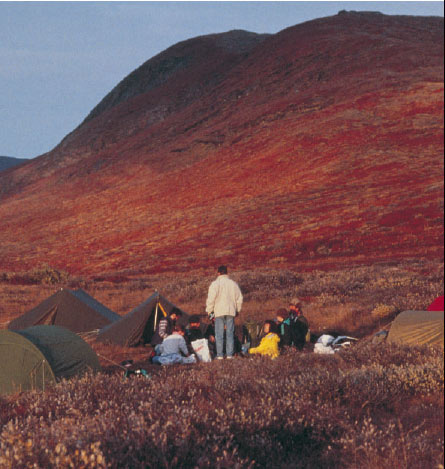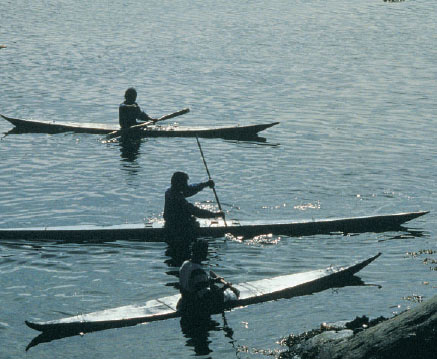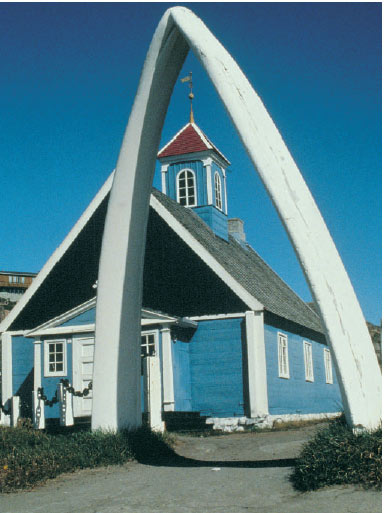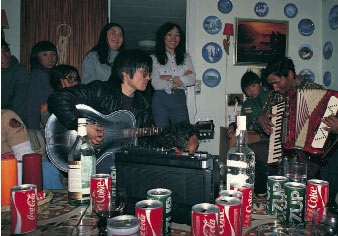The Danish-Greenlandic Environmental Cooperation
On land, at sea and in the airTourism has been proclaimed the leading industry of the future in Greenland. What is the status of tourism at the moment? What direction is tourism moving in now? Does eco-tourism, in particular, have a chance in Greenland?

Mountain tourism is already well developed in the area around Kangerlussuaq (Sønder Strømfjord)
In 1992, the Home Rule Government of Greenland drew up a ten-year plan for the development of tourism in Greenland. Future development in the country would not focus exclusively on marine resources. At the same time, there is a lot of potential in Greenland for tourism, since it can offer experiences that suit current trends. There are few people in Greenland; there are great natural amenities, as well as a primeval character that tourists cannot find many other places in the world.
The masses or the elite?Some people in tourism in Greenland say decidedly that it will take a lot of marketing to get many tourists to Greenland. Others think that marketing is unnecessary, because Greenland sells itself.
The main question is whether the focus should be on mass tourism, or on the elite. The answer will be found at the end of this chapter.
As it is now, Greenland does not get mass tourism. Each year, 31,000 tourists visit Greenland, which is much less than the number that visit LegoLand in one day.
Current tourism is concentrated on the west coast near the two airports and the bigger cities.
Outfitters
For two years, Jeppe Mordhorst, who is paid by Dancea, has been a leading promoter of creating tourist attractions in Greenland. Boat rides in Narsaq and Nuuk. Dogsled trips and small excursions in Sisimiut and Ilulissat. He has worked to create activities for well-heeled tourists that want exclusive experiences.
"We studied gorilla tourism in Rwanda - before everything fell apart. It was a very exclusive form of tourism. There was no need to market it. There was a waiting list. There were only two tribes of mountain gorillas. People paid 35,000 crowns (c. 4200 US dollars) just to take part. Plus plane tickets and hotel accommodation. The same is true of polar bear tourism in Canada. It costs up to 90,000 crowns (c. 11,000 US dollars) for two or three weeks on a dogsled looking to see a polar bear. If you focus on quality with exotic forms of tourism like that, the marketing takes care of itself."
His main aim was to get some operators going. There were thirty-five outfitters, Greenlanders mostly of modest means - one had a boat, one drove dogsleds, one had two cabins up in the mountains, and so on. Not big hotel owners, Greenlandic hunters. They were brought together by Greenland Tourism for at two-week basic program: a little English, a little marketing, a radio certificate, a first assistance course. The program was held at the business school in Qaqortoq.
Sustainable tourismIs it possible to create tourism that is not destructive to nature? Where you consume as little as possible? Where the local community benefits from the activities? Ecotourism, in short.

When you arrive in Greenland by plane, you have already used up your global energy quota for many years into the future.
"Oddly enough, the requirements for eco-tourism are extra high," says Jeppe Mordhorst. "It is a very big thing to demand that the local community be involved. If a farmer wants to convert to organic agriculture, he just converts. He doesn't go ask his neighbour if he wants to convert too, because otherwise the pesticides will be blown over. Maybe he should, but the requirements for eco-tourism are much higher."
Big animals sell
You could say something terribly exciting about an interesting wolf spider, how it has adapted to freezing temperatures, etc. But it would not create a sensation. It takes more than that, it takes whales or musk oxen.
That is why some outfitters wanted to do musk ox trophy hunting. Presumably the greatest concentration of musk oxen is found not far from the airport in Kangerlussuaq.

Cultural tourism: here the ruins of the Norse church in Hvalsey
"It turned out that there was a market for a summer hunt and a winter hunt for musk oxen. In the winter, pretty much everything can be transported by dogsled. In the summer, you can't get into the area except by helicopter. The alternative is a big fourwheel drive. That is perhaps even worse for the environment than flying by helicopter," says Jeppe Mordhorst. "We said - Let's do it as well as we can, and then we can raise the standards later on."
Being a tourist guide on a musk ox trophy hunt is hard work. It requires a high standard of service. The beer must be cold and ready as soon as it is wanted. You have to tell stories about flowers and bees. It is really tough being a trophy hunt organizer.
The result was that many environmentally friendly ideas were introduced. From collecting cigarette butts to not burying plastic, and about transport, animal welfare, and how to shoot the animals. The latter is not something Greenlandic hunters were too concerned about. But it means a lot to the German business manager cum trophy hunter. Perhaps it does not mean much with respect to the environment. Nevertheless, it helps give the trophy hunt a green profile.
Once nature becomes an economic asset, taking care of it becomes more interesting. That is the idea behind ecotourism.
OvercrowdingTourist rides on dogsleds are a good example of sensible eco-tourism. It also contributes to keeping that aspect of the culture alive. Dogsledding is declining fast.

Natural tourism: here a "pingo", which appeared when the soil that had thawed in the summer was squeezed in the fall between the permanently frozen bottom layer and the newly frozen top layer of soil. When that happens, volcanolike formations can form, like here.
In Sisimiut, there have been confrontations between dogsledders and snow scooter drivers.
This is linked to the paradox that even though there are so few tourists, and Greenland is such a big country compared to its population, still, there is not enough space, because all activities take place in the same local areas.
Dogsleds drive the same way again and again. After ten minutes, the first snow scooters passes at full throttle. The smell of gasoline is left hanging in the narrow valley. Ten minutes later, the next one comes. It is difficult for the person that wants to drive a dogsled - real eco-tourism - to sell his product. Gasoline fumes from snow scooters are not mentioned in the advertisements. Only polar bears and the great calm.
The overcrowding has made many outfitters give up. The customers were disappointed. Things did not live up to the advertisements. And that is an element of eco-tourism, that the marketing must be honest.

Newly built Greenlandic skin kayaks in Sisimiut.
"My great idea with eco-tourism was that tourism could be use to get people interested in taking care of nature in Greenland," concludes Jeppe Mordhorst.
He does not think that all tourism in Greenland should be eco-tourism, only that it could be a relatively large niche.
The director of the tourist association
"The picture in a tourist's mind when he imagines Greenland is dogsleds and kayaks. It is the Greenlandic family and the drum dance. It is the mask dance and choral singing. It is the national costume and its history." As managing director of the tourist association in Sisimiut (Holsteinsborg), Anette Grønkjær Lings knows what makes Greenland sell.
She works with three "pillars". The first is that the city and the area around it should be presentable. The second is culture. And the third is discovery tourism: sailing, snow scooters, dogsleds, and fishing.
Anette Grønkjær Lings mentions wear and tear on nature as the greatest threat to the environment. "We have a very big country, but things that get trampled down take many years to grow up again."
Knud Rasmussens Højskole, the first school of its kind in Greenland, is located in Sisimiut, and works especially with Greenlandic culture. It is the local population that attends the school. On the harbor in one of the old warehouses, a workshop for Greenlandic arts and crafts has been set up.
She is very enthusiastic about the kayak club readopting old Greenlandic kayak disciplines with the kayak turns and so on.
Skiing
Kayaking is a sport in Denmark. Is that the tendency in Greenland, turning the hunters' ways of moving around into sports?
"Here in Sisimiut (Holsteinsborg) we have a lot of skiing because of the Arctic Circle Race, which is one of the trademarks of Sisimiut. Besides that, the municipality has a system of cross-country routes ready all winter," explains Anette Grønkjær Lings.
Everything seems to indicate that extreme sports of this kind are increasing. Besides the Arctic Circle Race, there is also skiing in eastern and southern Greenland. The latter is called the Greenland Adventure Race, and takes place in the summer. It resembles the triathlon: biking, skiing, and sailing. Greenland is ideal for mountain bikes. And south Greenland is especially good because the towns are reasonably close to each other.
It is striking that not only elite skiers sign up. Ordinary people, too, are interested in achieving something out of the ordinary, and would like to challenge themselves in nature. It is not for nothing that the Arctic Circle Race is called the hardest ski race in the world.
Organization in nature
There are conflicts between the dogsledders and the snow scooter drivers. But in Sisimiut there are strict rules for where snow scooters can be driven. There is only one place where the two paths cross. The hunting areas are prioritized in this connection, not tourism. If you drive a snow scooter in the hunting areas, you risk scaring the game animals. That is why they have decided in Sisimiut not to allow hunting from snow scooters.
As managing director of the tourist association, Anette Grønkjær Lings would of course like to have as many customers as possible, but how much can the area sustain?
"The area between Kangerlussuaq and Sisimiut gets a lot of attention. People like to go hiking there in the summer and there is a three-day dogsled race there in the winter. If we made sure to take our garbage away with us, then the environment would be able to sustain more than it does today. There is some empty hotel capacity. What we need is organization," concludes Anette Grønkjær Lings, who dreams of arranging dogsled trips to the nearby glaciers during the summer.

Entry arch made of the lower jaw of a Greenland whale. The old church of Sisimiut is seen in the background.
The professionalsJulia Pars from Greenland Tourism promotes professionalism. One of the first things she remarks, when I happen to meet her in the airport in Upernavik, is that the business school in Qaqortoq graduated five people from their tourism program in both 1999 and 2000. The program is three and a half years long.
"If I were to name a success, it would be ice golf. An idea that was created in Uummannaq," says Julia Pars, who works as a development consultant for Greenland Tourism. "Another success is the ice hotel in Sønder Strømfjord. It is a series of snow cabins, where you sleep on an ice bed covered with musk ox skins. There is candle light. In one of the igloos there is an ice bar, where you can have your drink in an ice glass."
The idea came originally from northern Sweden - Jukkasjärvi - in Lapland. There is an ice hotel there that now covers 3,000 m2. "We got the idea of setting up the ice hotel in Greenland on a study trip with a Japanese agent," explains Julia.
She thinks that these slightly zany ideas are good because they create a lot of PR in other parts of the world. I ask Julia Pars if sustainable tourism or eco-tourism have a future in Greenland.
"Sustainable tourism," muses Julia Pars, "I understand that to be tourism that you can live both off and with. That it treats both tourists and local people decently. It's not about changing everything just so you can attract tourists, but at the same time giving them professional service based on the conditions here in Greenland."
"In Greenland Tourism we are not counting on eco-tourists. We focus on the ordinary tourists who are looking for new experiences," concludes Julia Pars.

The average tourist in Greenland is Danish, arrives in a plane, spends five to seven days in one or more towns, and uses the towns as a base for sailing or hiking trips. The focus is mostly on activities in nature.
About 31,000 tourists come to Greenland each year. Over eighty percent of the tourists come from Denmark. The Germans are next.
It is the well-to-do tourist that they are counting on, because it will never be cheap to travel to Greenland. The average trip costs 10,000 to 30,000 crowns (c. 1200-3600 US dollars) per person. That is, in itself, a limitation. Everyone is welcome, of course, but the majority of the guests are "gray panthers"; typically a bit older, whose children have flown the nest, and who are maybe missing just one more dot on the map or have always dreamt of coming to Greenland. Greenland is very exotic, and is somehow strongly connected to Denmark.
